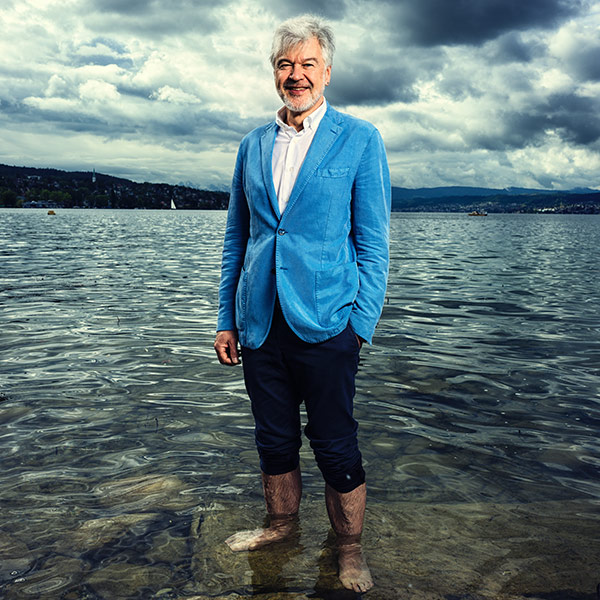Economics in ethics
The cost of a human life
An individual is worth CHF 7.4 million, while 30 soldiers are worth 1.2 tanks. From transport infrastructure to health to armies, we are accustomed to calculating the monetary value of a human life. We take a closer look at the math.

How well do all these road markings really protect the cyclist? And how much money needs to be spent on them? All this information flows into the cost-benefit analyses of transport infrastructure projects. | Photo: Karin Hofer / NZZ
How much is a human life worth? The answer depends on who you ask. A parent will probably say that her or his child’s life is invaluable. In the eyes of society as a whole, however, it is different. In Switzerland, the value that the nation attributes to an individual reached 7.4 million francs in 2023. This is the voice of the Federal Administration saying so, more precisely the Federal Office of Spatial Development (ARE), on the basis of a skilful calculation (see box). “This is a statistical concept, which represents what a company is willing to pay to avoid death”, says Joséphine Leuba, a project manager at ARE.
The calculation of the value of a statistical life
To establish the value of a statistical life in Switzerland, the ARE adapts OECD figures according to the changes in Swiss gross domestic product (GDP) and the level of prices. The OECD compiles a meta-analysis of a large number of international studies. “The interviewees are faced with concrete decisions that, on the one hand, lead to a slight change in the risk of death and, on the other hand, have a financial cost”, says Joséphine Leuba.
She gives the example of the renovation of a roundabout that would reduce the annual risk of a fatal accident by 0.01 percent. Knowing that the work involves costs of CHF 700 per person, should it be carried out? The amount and the level of risk proposed vary according to the respondents, which makes it possible to identify the collective readiness to pay. If the accepted costs for a reduction of the probability of death are converted into a 100-percent probability, this corresponds to the value of a statistical life.
This indicator has been used since at least 2004 by ARE as part of the statistics on the external costs and benefits of transport. It doesn’t stop there; it also uses it in the field of transport for cost-benefit analyses of infrastructure projects. For example, should a roundabout be secured? “A project that reduces the risk of death will have a chance at being adopted, even if it costs more than its alternative”, says Leuba. It specifies that when the risk of mortality increases with age and its distribution is known, as with air pollution, another measure is used: the value of a year of lost life.
Natural hazard protection measures also take into account the “statistical life value” at ARE. “The risk for people is calculated as the number of expected deaths, multiplied by the value of the statistical life to express it in francs”, says Linda Zaugg-Ettlin, a technical collaborator at the WSL Institute for the Study of Snow and Avalanches SLF. This conversion into financial value makes it possible to consider human and material risks in the same equation, and to integrate the costs of potential interventions.
Death in one in a hundred thousand cases
Let’s take the example of avalanches. Two questions arise before putting in place a prevention measure: first, is it effective? “In other words, does it reduce the risk to an acceptable level?” says Zaugg-Ettlin. The individual risk of death plays an important role here: “The probability that a given person dies due to a specific natural hazard must be less than one in 100,000. If it is higher, an intervention is necessary”.
Second question: do the benefits outweigh the costs? “The benefit of a measure is the protection it provides”, says Zaugg-Ettlin. This protection is also expressed in francs and corresponds to the savings achieved when we compare the risks before and after intervention. A measure is considered efficient if the protection it provides is greater than its costs – including construction, maintenance and annual operation. Its implementation is then economically justified.
Zaugg-Ettlin points out, however, that the economic efficiency of a protection measure is only one of the aspects that the Federal Office for the Environment takes into account. “Other important factors include environmental compatibility, technical quality requirements and social acceptance. For the last of these, factors that are more difficult to quantify can be taken into account, such as securing an important regional transport route, or preserving significant cultural property, e.g., a historic church”.
In health too, quantifying life is inevitable. No community, no matter how rich, can afford to reimburse all medical treatment. Where to set the limit? It is not the value of the statistical life as calculated by the ARE that serves as a reference in this area, but a judgement of the Federal Supreme Court of 2010. The Court had looked into the case of an orphan drug against Pompe disease, a progressive genetic disease causing muscle damage that can be fatal. In the decision, the judges write that “expenses of a maximum order of about CHF 100,000 per year of life saved are considered reasonable”.
Maximise the good
Samia Hurst is a bioethicist and doctor. Among other things, she directs the Department of Community Health and Medicine at the University of Geneva. For her, attributing a value to life makes it possible to do as much good as possible with the resources available: “When we ask ourselves how much to spend on health, we have two options. Either we give a monetary value to life, or we do not do it and we consider that it has infinite value. In this second case, there is no ceiling on acceptable spending to save lives and we will exhaust resources in pure loss”.
Hurst was also a vice-president of the Covid-19 scientific task force. Did the prevention measures take into account the value of statistical life? Not so simple, she says. “We can’t just look at what the prevention measures cost and put them against the lives saved, because it is already very difficult to assess the cost of the measures. Then, we would have to know what it would have cost to do nothing. But here too, it’s complicated”. What’s more is that “for a long phase, the epidemic was killing the economy better than the measures could. Because the virus was here. People were sick, they were afraid, went out less, consumed less”.
War, another logic
There is one area where the appreciation of the value of life changes abruptly: armed conflict. “War is another logic”, says Laurent Goetschel, a professor of political science at the University of Basel and the director of Swisspeace. He remembers his military service in the infantry in 1985: “Our unit was composed of 20–30 people. We were told that in case of war, once we had destroyed 1.2 enemy tanks, we could all die. That was our collective value”. The State is waiting for its citizens to be ready to sacrifice themselves for it, and its existence is worth more than the sum of the individuals who compose it, he says.
With the entrance of artificial intelligence into war, will the value of life now be defined by algorithms? “It is humans who set the parameters of algorithms”, says Goetschel.
What is especially striking to Goetschel is that the difference between civilian and military actors is increasingly ignored. “A short time ago, the fact that a bomb could fall on a wedding party aroused fear. Now, people are killed during the distribution of humanitarian aid without anyone being interested. International humanitarian law is flouted. There is an impressive and appalling devaluation of what the loss of human life means”. What’s happening? “We are witnessing a movement where war is again considered something normal”, says Goetschel. “As soon as it becomes normal again, however, the value of the individual decreases”.



